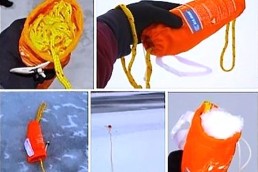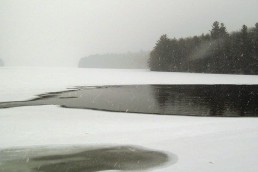Through-the-ice Rescues
SHARE THIS POST
Hearing the lake ice pop and snap as we trekked across the frozen Boundary Waters lake in the dark of winter wasn’t so bad. Nor was it too disconcerting as the mantle of snow-crusted ice gave slightly under the weight of my snowshoe, stepping across a frozen Mississippi backwater slough. Breaking through river ice 50 miles north of Fairbanks, Alaska, in February, at -30 degrees—that was a wakeup call!
All three scenarios are my personal experiences crossing ice. Three types of water bodies; three different “personalities” of the frozen water. All speaking to me loud and clearly, reminding me of the number one rule of winter traveling—ice is never 100% safe!
Two feet here, two inches there
Consider that Alaskan river: frozen upwards of 24 inches thick. I was helping a wildlife biologist with the BLM conduct some routine ice thickness measurements along a section of a major watershed river. We had just drilled a hole through nearly two feet of ice capping the entire width of the channel, only to realize we forgot the stick gauge used to determine the depth to the riverbed. I headed towards the nearest cut-bank. Long, straight alder stems arched out over the bank.
Blooosh! I was within about 10 feet of the embankment when the ice beneath my feet suddenly fell away. Water instantly began gushing up through the fractured chunks of ice. I lunged forward, grabbing onto the nearest branch as I rolled sideways onto firmer “ground.” I don’t know how deep it was right at the cut-bank, but it was the closest call I’ve ever had to actually falling through the ice.
Moving water—whether on a river, or spring/creek-fed lake—constantly affects both the formation and characteristics of ice that can form as temperatures drop. Pockets of unsafe/bad ice can occur adjacent to or within rock-hard sections otherwise solid enough to support a vehicle.
Recent fluctuations in temperatures (freezing-thawing-freezing), changing snowfall and accumulation depths plus the continuing changes from other influences (volume and speed of incoming waters flowing under ice from incoming streams, for example) are all contributing factors affecting the dynamics of a body of frozen water.
Tick tock
Good ice generally looks good, it’s clear/blue, it shimmers and glimmers and has a good sound to it. One trick for checking ice is to tap it with a metal ski pole or walking stick—if you hear a “tick” sound, that’s good; a “tock” or dull sound means the integrity of the ice is questionable.
Treating all expanses of ice as potentially dangerous is the safety-conscious approach to venturing out across a stretch of frozen water. Keeping a fair distance between travelers and staying in the leader’s tracks are good tactics when on foot or machine.
An unexpected route to relaxation
Once you’ve fallen through the ice, you’ve just raised the ante exponentially! As cold and shocking as it is, the very first thing one needs to do—especially in a self-rescue situation—is to try to relax. Seriously! Frantically submerging and gulping ice-cold water is the worse thing you can do. Within just a few seconds of relaxing, your body can adjust enough for you to muster what you need to do to escape the life-draining cold water around you.
Before discussing ways to exit the water, it’s of critical importance to remember to always work at exiting back out of the hole back towards the direction you were traveling at the time of the break-through. You know that ice is safe. You need to get back out of the hole in the direction you approached it!
Are you enjoying this post?
You can be among the first to get the latest info on where to go, what to use and how to use it!
Rescuing someone is best accomplished by sliding a hand-hold or platform (branch, ladder, paddle, etc.) out to the victim while talking them through the processes. You need to act fast and also keep yourself on solid ice. You can also employ a throw bag or simply a looped rope.
Thick, insulated winter coats can trap enough air to give you a few minutes of flotation. Facing back to your exit point, you may have to break off thin edges of ice before finding a solid platform. It’s important to keep your arms up out of the water and onto the ice as you try to raise your legs and kick (like you are swimming) and thrust your body forward onto the ice.
Get rescued, not recovered
If you tire before being able to extract yourself, keeping your arms out on the ice may cause them to freeze in place—at least holding you on the surface and aiding rescuers if you become unconscious before they arrive. It’s still better to do what you can to be rescued and not recovered.
Wearing/carrying ice awls—small hand-held ice picks—can help you grab onto the slippery ice surface. You can buy sets or make your own. Either way, they are good winter survival tools to have with you any time you venture out onto ice.
Once you are up onto solid ice, stay prone and crawl away from the hole until you can roll farther away from the compromised ice. Finally, stand up and return to shore or safety. Your battle isn’t over. Wet clothing can quickly lead to the onset of hypothermia. Wearing wool or fleece layers, wool socks and/or wool/felt boot liners can all help keep you warm—even after a frozen dunking.
After my escape from that near submersion, I noticed that my wool bib pant legs were only soaked up to mid-thigh. Just a little water had entered by boots (felt lined and wool socked). Although my skin would be wrinkled and clammy, I managed to continue working outside at below-zero temperatures for another hour before heading back to a not-so-warm truck.
A hardcore windbreaker
Arctic natives would purposefully dampen their outer leggings so they would freeze—becoming a wind barrier by forming an outer ice shell of frozen pants material (treated animal skin) to help retain heat within.
Humans will never beat the cold, but we can certainly do our best to team up alongside it and be cold-weather thrivers, and not just survivors.
Tom Watson is a former team member of Kodiak Island Search & Rescue, kayak tour operator, and author of “How to Think Like a Survivor: A Guide for Wilderness Emergencies”; “Best Tent Camping – Minnesota”; “60 Hikes Within 60 Miles Minneapolis and St. Paul” and “Best Minnesota Camper Cabins.” (All available on Amazon.) He’s a freelance writer and presenter on self-reliance and other outdoor topics. tomoutdoors.com.
MWO
SHARE THIS POST
You may also like...
Did you enjoy this post?
You can be among the first to get the latest info on where to go, what to use and how to use it!
Tom Watson
Tom Watson is a former team member of Kodiak Island Search & Rescue, kayak tour operator, and author of “How to Think Like a Survivor: A Guide for Wilderness Emergencies;” “Best Tent Camping—Minnesota;” “60 Hikes Within 60 Miles Minneapolis and St. Paul” and “Best Minnesota Camper Cabins.” (All available on Amazon.) He’s a freelance writer and presenter on self-reliance and other outdoor topics. tomoutdoors.com.


